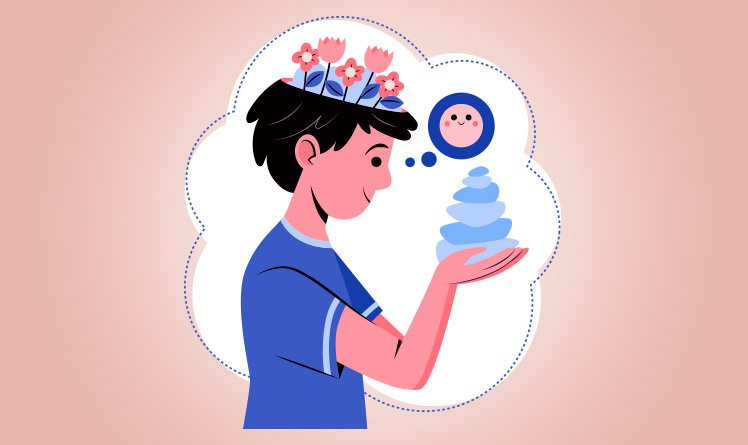Dopamine: what it is, what it is for and how to increase it naturally

|
Getting your Trinity Audio player ready...
|
If you've ever felt that burst of joy when you receive good news or the satisfaction of crossing a task off your list, know that behind this experience there is a silent protagonist: dopamineThis neurotransmitter has been called the “motivation molecule” because it is directly linked to how we seek pleasure, rewards, and purpose in life.
But dopamine isn't just about happiness. Therefore, when balanced, it helps us focus, learn, and pursue goals. On the other hand, when out of balance, it can be at the root of procrastination, self-sabotage, anxiety, depression, and even addictions.
“Dopamine is a fundamental neurotransmitter for motivation, pleasure and learning, regulating behaviors and emotions in everyday life.”
Throughout this article, we'll dive deep into the science and practices to understand what dopamine is, how it works in the brain, how it impacts human behavior, and, most importantly, how to increase its levels naturally and in a balanced way.
What is dopamine?
Dopamine is a neurotransmitter, that is, a molecule that transmits signals between neurons. Produced mainly in regions of the midbrain, such as the substantia nigra and the ventral tegmental area, it spreads to areas such as the prefrontal cortex and the nucleus accumbens, regulating motivation, focus, emotions, and movement.
It wasn't until the 1950s that scientists began to understand the importance of dopamine. Studies of Parkinson's disease—characterized by the degeneration of dopamine-producing neurons—showed how essential it was not only for movement but also for pleasure and motivation.
“Dopamine is a brain chemical that acts as a messenger, essential for motivation, learning, pleasure, and movement.”
And here's the first big misconception: many people think that dopamine is the same thing as serotonin. Although they work together, the two have different functions:
- Dopamine: is linked to motivation and the desire to achieve rewards.
- Serotonin: regulates mood, calm and a sense of well-being.
So, we can say that serotonin gives us contentment, while dopamine gives us energy to pursue what we want.
What is dopamine for in the body and mind?
Dopamine participates in vital processes for human life. Its best-known functions include:
- Motivation and focus: It's the fuel that drives us. Therefore, without dopamine, we lack the energy to act.
- Pleasure and rewards: Every achievement, big or small, releases dopamine. In other words, it's the feeling of victory when you complete a project or even receive a like on social media.
- Learning and memory: dopamine strengthens neural connections, helping to consolidate what we learn.
- Motor control: adequate levels are essential for coordinated movements.
For example, when you complete an important task at work, your brain releases dopamine. This reward signal increases your chances of repeating the behavior in the future.
On the other hand, when dopamine is low, symptoms such as lack of energy, discouragement and difficulty concentrating may appear.
Dopamine and human behavior
The brain is a machine that seeks pleasure and avoids pain. And dopamine is at the heart of this process. Think about the sensation of checking your phone for notifications: with each like or message received, a small dose of dopamine is released, reinforcing the habit of repeating the action.
This mechanism, called the dopaminergic reward system, explains why we often fall into cycles of immediate gratification, such as scrolling through social media, eating sweets, or procrastinate difficult tasks.
“Dopamine directly influences human habits, reinforcing both positive behaviors and patterns of addiction or procrastination.”
When left unchecked, dopamine can sabotage us, leading us to autopilot in the pursuit of quick pleasure. But when channeled toward larger goals, it becomes key to maintaining purpose, discipline, and long-term motivation.
Dopamine under the lens of Neuroscience
Neuroscience shows that dopamine acts in key areas of the brain, including:
- Prefrontal cortex: responsible for planning and decision-making.
- Limbic system: regulates emotions and immediate pleasure.
- Nucleus accumbens: center of the reward system.
These regions are part of the so-called mesolimbic dopaminergic circuit, which is essential for learning from rewards and avoiding punishment.
Additionally, dopamine circulates in four main pathways in the brain:
- Mesolimbic pathway – connects the ventral tegmental area to the nucleus accumbens. It is the classic pathway for pleasure and reward.
- Mesocortical pathway – links dopamine to the prefrontal cortex, regulating executive functions such as planning, focus and decision-making.
- Nigrostriatal pathway – responsible for motor control, related to Parkinson’s.
- Tuberoinfundibular route – regulates the release of hormones by the pituitary gland.
These pathways show that dopamine is not just about pleasure: above all, it participates in hormonal regulation, motor coordination, and even how we deal with risks and uncertainties.
Another crucial point is that dopamine is released not only when we receive a reward, but also in anticipation of it. This is why the anticipation of a pleasurable event can be as exciting as the event itself.
When balanced, dopamine promotes learning, motivation, and well-being. However, in excess, it can lead to compulsive behaviors (such as gambling or substance addiction). A deficiency can be linked to depression, apathy, and even neurological diseases like Parkinson's.
How to increase dopamine naturally
The good news is that we can stimulate dopamine production without resorting to external substances. Here are the most effective practices:
Balanced lifestyle
- Physical exercises: increase dopamine and improve receptor sensitivity. Above all, aerobic activities and strength training are highly effective.
- Quality sleep: sleep deprivation reduces dopamine availability and the ability to maintain focus. In other words, a good night's sleep sleep is essential for the production of dopamine.
- Tyrosine-rich diet: This amino acid is the precursor to dopamine. It is found in eggs, fish, pumpkin seeds, avocados, and bananas.
- Sun exposure: regulates not only dopamine, but also serotonin and vitamin D, which are essential for mood.
Mindfulness
Practicing mindfulness helps balance the reward system. In this sense, observing thoughts and emotions without judgment helps reduce the pursuit of automatic gratification.
Practical exercise: Breathe deeply for three minutes, focusing only on the air coming in and going out. When you notice distractions, return to the present without criticizing yourself. This practice increases the prefrontal cortex's control over dopaminergic impulses.
Positive Psychology
Instead of waiting for big achievements to feel pleasure, we can train our brains to value small victories. Practices like gratitude journaling (writing three things you are grateful for), recognizing progress and cultivating positive emotions activate the dopaminergic system in a healthy and lasting way.
NLP (Neuro-Linguistic Programming)
NLP teaches techniques to reprogram mental patterns. One of them is SWISH technique, which replaces negative images with positive ones. Above all, this shift activates new brain circuits and creates internal rewards, stimulating dopamine aligned with long-term goals.
Dopamine, addictions and self-sabotage
Dopamine is also behind many modern addictions. Social media, gaming, pornography, and ultra-processed foods act as "quick shots" of dopamine, creating cycles of compulsion.
However, this excess wears down dopamine receptors, causing the brain to require ever-increasing stimulation to experience pleasure. This is where self-sabotage arises: we trade lasting achievements for fleeting highs.
The concept of dopamine detox emerged as a response to this: reducing artificial stimuli (such as cell phones and sugar) to rebalance the reward system. On the other hand, although scientific studies on this detox practice are recent, it can help regain control over natural pleasure.
Individual differences: why do some seek more pleasure than others?
Dopamine doesn't work the same way for everyone. Research shows that genetic variations, such as those in the DRD4 gene, influence dopamine sensitivity. In other words, people with certain variants tend to seek out novelty more (novelty seeking), which can be both a source of creativity and impulsiveness.
This explains why some people seem to need constant stimulation, while others are satisfied with small rewards.
Dopamine from the perspective of Positive Psychology and Mindset
Within the model PERMA, from Martin Seligman's Positive Psychology, dopamine is especially related to:
- Engagement (E): feel absorbed in pleasurable activities.
- Achievement (A): achieving goals releases dopamine and boosts self-confidence.
- Positive Emotions (P): pleasure and motivation are deeply linked to dopamine.
Thus, when we align dopamine with our life purpose, we leave the cycle of seeking immediate pleasure and begin to build sustained motivation — a fundamental step in reprogramming our mindset.
Dopamine care
Dopamine can be an ally or a trap. Too much of it can lead to compulsions, addictions, and even mental health disorders. Too little of it can cause depression, apathy, and a lack of energy.
"Dopamine balance is essential for mental health. Not too little, not too much."
The secret is to cultivate habits that stimulate dopamine in a balanced way: natural rewards, a clear purpose, and practices that unite body and mind.
In short…
Dopamine is much more than the "pleasure neurotransmitter": it's the vital energy that drives our choices, reinforces our habits, and drives us to action. Therefore, when we learn to balance this chemical messenger, we stop being hostage to immediate gratification and begin to build a life of focus, purpose, and fulfillment.
Therefore, uniting science, mindfulness, positive psychology and NLP, you can direct dopamine to your advantage, transforming small, everyday actions into fuel for big changes.
FAQ – Frequently Asked Questions About Dopamine
1. What is dopamine in a nutshell?
Dopamine is a neurotransmitter that regulates motivation, pleasure, learning and movement.
2. What is the difference between dopamine and serotonin?
Dopamine generates motivation and the pursuit of rewards; serotonin regulates mood and well-being.
3. How do I know if I have a dopamine deficiency?
Lack of motivation, apathy, difficulty focusing and lack of pleasure in activities are common signs.
4. What foods increase dopamine?
Bananas, avocados, fish, eggs, nuts, dark chocolate, and pumpkin seeds are rich in tyrosine.
5. Is too much dopamine bad for you?
Yes. Excess is linked to addictions, compulsions, and risky behaviors. The ideal is to maintain balance.
Image: Freepik

Marcel Castilho is an expert in neuromarketing, neuroscience, mindfulness and positive psychology. In addition to being an advertiser, he also has a Master's degree in NLP – Neurolinguistic Programming. As the owner and founder of the communications agency VeroCom and also of the digital agency Vero Contents, he has been studying human behavior for over 30 years.

